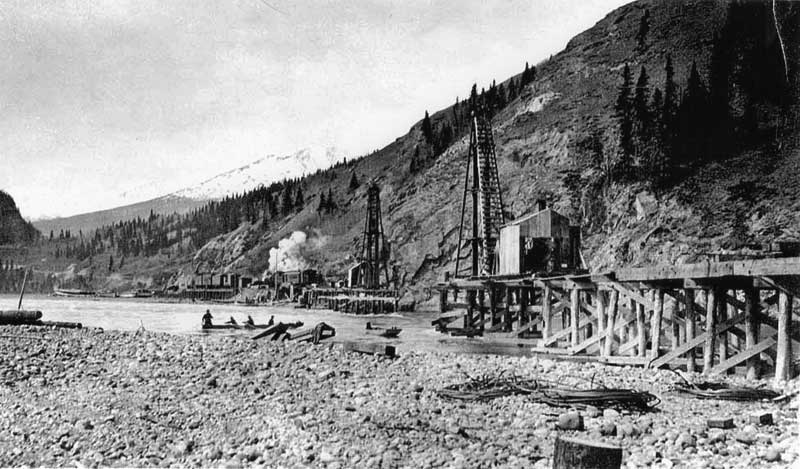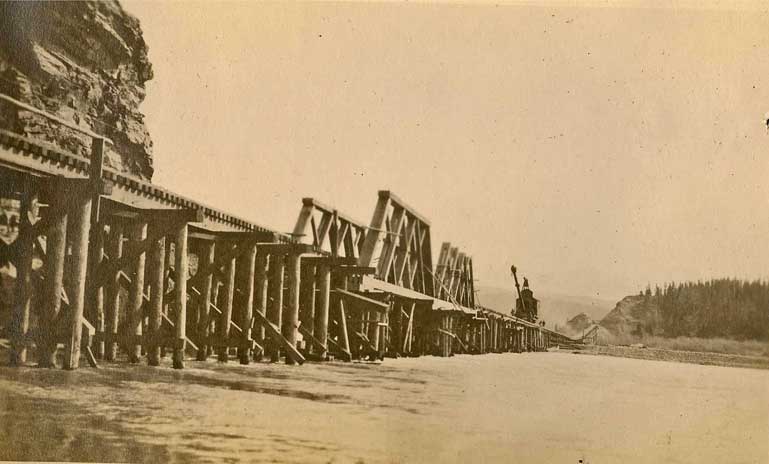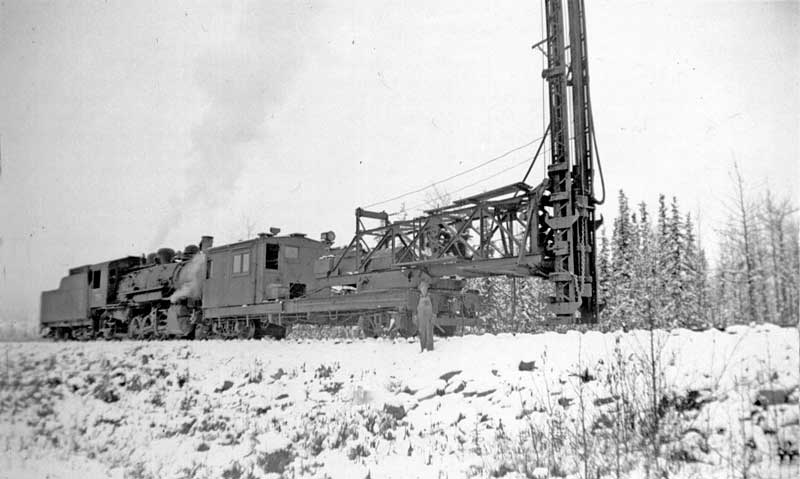Legacy of the Chief, Chapter 15: "Chitina Trestle Crossing" |
click on picture for larger image: some of these images appear in the book for this chapter. |
“Until then, I think Nicolai had been inclined to look upon the railroad as a just a dreaded extension of the white man’s power, but one which could be endured. Wouldn’t you agree, Uncle Tanas?” “Yes, it was a shock for all of us, but particularly him because he had tried to convince everyone to go along with them. He felt betrayed. He wasn’t quite so tolerant of them after that. We were there the next day to begin retrieving all the disturbed bones and other pieces scattered around the old grave-site. We gathered everything that was left and moved it all to a safer place. “Poor old Eskilida took a long time to recover. He was already getting along in years. He suffered several broken bones. We younger men decided we would get revenge no matter what, but we still asked Nicolai what we should do first. Maybe what we were really telling him was that we wanted him to do something. In the end, Nicolai, because of his spiritual power, did more damage than the rest of us combined.  Looking down Eskilida trestle toward the Eskilida fish camp. --Cordova Museum “We did not know for certain which men disturbed the graves, but we knew who beat Eskilida. Those men had come from Haley Creek, where a large tent camp was set up. We knew we couldn’t attack the camp. It had too many white men there, or we would have gone down and finished it right then.” “Nicolai, Billum, Eskilida, Goodlataw and the other elders gathered at Taral where they stayed in retreat for several days. None of them ever told us what they did, but we can guess. “All the elders were sleep-doctors. The word got around that the sleep-doctors had placed an evil curse on the railroad. We suspected that it was a curse on all white men who had any part of the railroad or the copper mines, all the way up to the very top of management. It had its effect. The first one to go was the railroad contractor, Big Mike Heney, the biggest Irishman of them all. It wasn’t long before the head railroad engineer, E.C. Hawkins also unaccountably lost his life.” Johnny, Cap and Violet all listened to their uncle intently as Tanas related the strange occurrence. “The curse took on a life of its own, which is the nature of such demon-spirits. It just kept growing. Soon all who entered our land uninvited by us were in danger of becoming a victim of the curse.” “You really believe Nicolai and the elders had a strong curse like that, Uncle Tanas?” “Nicolai wouldn’t say. Neither would anyone who was over there, except Chief Goodlataw. He’s my friend, so I talk to him often. He told me that they started something very small, but it grew very big. He said the elders themselves grew afraid of what they might have done, but they were even more afraid that if they said anything, it would grow even more. So they remained silent. “They raised something none of us would want to even contemplate out of the dark depths of the earth. It is an evil spirit which stalks our land to this day. Never before had so many sleep-doctors gathered together to do so much damage, not since the days when the Mendaesde Ahtnas slaughtered the Russians. “The nature of what they did required a strict vow of silence. No one could know outside of their small group what had really happened over there at Taral. All they told us was that the matter of the desecration of the graves which angered the spirits of our ancestors had been dealt with. We were told to wait. “But we were not satisfied. We young men decided to take matters into our own hands. We stole or destroyed property of the workers and of the company itself. Then we started to isolate small groups of white men and beat them. We did everything we could think of to let the company know how we really felt. “Incidents of fighting between our people and the railroad workers increased until we were almost in a full state of war. Something had to be done, because it was getting out of control. “But the wave of violence and looting did not stop until we, the sons of Nicolai, Eskilida, Billum and others, finally isolated the Irishmen we were sure were responsible and beat them to within an inch of their lives. We caught them at a bar in Chitina. They had to be lunatics to be there where we could get to them. We practically destroyed the bar in the process. After that , we weren’t allowed into any bars again. We didn’t care. Those were white man places, anyway. We finally restored honor to our people. It was all that mattered to us. “This was when Nicolai forced those concessions from Stephen Birch. Once he got what he wanted, Nicolai then told Birch that the fighting, the stealing, and the vandalism was over. We now felt that once again the land was ours.”  photo from Lauria Nyman Collection "Wooden Bridges, Trestles and Snow Sheds Between Cordova and Chitina there are 129 bridges, with a length of 42,988 feet, or 8.15 miles, which were built at a cost of $590,000. This side of Miles Glacier, mile 47, there are 40 bridges, length 17,963 feet costing $256,000. From Miles Glacier to Tiekel, a distance of 52 miles, there are 42 bridges length 15,459 feet, costing $18,000. From Tiekel to Chitina, a distance of 32 miles, there are 47 bridges, length 9,566 feet, costing $163,000. The longest bridge is across the copper river just beyond Chitina, at mile 132. It is 2,790 feet long, or a little more than a half mile. The west approach to the Miles Glacier bridge is nearly as long. The Gilahina bridge is 890 feet long, from eighty to ninety feet high and was built in eight days." from: The Chitina Leader, April 1, 1911: "RAILROAD COMPLETED TO THE COPPER BELT" “Uncle Tanas, you speak very well for an Indian.” The three younger people laughed at Johnny’s words. Tanas was known to be an unusually well-read man, even more so than most of the local whites. Tanas took pride in his literacy, yet he was only able to rise to a maintenance foreman within the ranks of the railroad labor force. No one was interested in hiring an educated Indian into a meaningful job. Johnny continued his story now that Tanas had related his incredible tale. “The Irish have a character trait of tenacity which must have kept them from leaving the area completely. Somehow the group held together as a team and managed to gain a hold at Tiekel. They were too unruly and obnoxious to everyone else to last there, so the group was dispatched to the more isolated station at Cascade.” “How did you find that out, Sken’nie?” “George Brown told me about those men before he sent me out there. He never cared much for them, either, Violet.” “Those stupid, drunken Irish were so brazen that they started bragging about what they did to our sacred graves,” Cap said, speaking up for the first time. His face showed the pained expression he must have had when he first heard the Irish crew openly brag about the desecration. “Those were the graves of my family. Now we knew who these men really were. In their drunken stupor, they unmasked themselves. We had thought they were long gone. All this time we had been working with the very men who despised us the most and who had personally defiled the resting places of our ancestors. It was clear to both Johnny and I that their first beating in the bar in Chitina was not enough. We were eager and very ready to finish the job. We took them on right then and there.” “It was a pleasure to strike at these foolish and loathsome men,” Johnny added. “All the bad feelings we built up from having to live with these crude Irishmen was probably felt in the power of our punches. We were motivated by all that indignation which had built up over time. But after what we learned that night, nothing would have stopped us from taking the Irish on and beating all four of them senseless. “When it was over, we hand-trammed ourselves and Kay-yew-nee all the way back to Chitina that night, having no reason to stay in Cascade any longer, and very good reason to leave.” “Johnny and I thought we would be fired for sure, maybe worse,” Cap added. “Instead George Brown reassigned Cap and I to the Chitina maintenance yard. We’re happy to be working at home. No one ever said anything about the incident. The Irish stayed quiet, and neither Cap nor I ever said anything until now.” That was an interesting evening at Violets. We went there often that year to play poker. From the spring of 1917 off and on until 1927 Cap and I worked together on the all-Native crews, usually under Uncle Tanas. When we worked out of Chitina we stayed in the house the two of us had rebuilt for Shee-ya in 1914. The rest of the time we stayed in the one of the railroad cars provided for the crews. Often we’d end up at Violet’s after work. It was a very small place, but just right for playing cards. Sometimes Tanas or some of the others would join us. Uncle Tanas’s Native crew was the one assigned to pull the tracks and stringers before the river lifted the trestle bends and washed them down the river into oblivion. It was an annual occurrence. A local bridge superintendent watched the river and the trestle for the ideal time to stop railroad traffic and begin dissembling the bridge top. At the right time, he would order a crew to pull the rails and stringers over the pilings before the ice shoved the bridge out. This way the material loss was limited to only a few pilings. Then the crew could rebuild the bridge using the original material. The damage when the ice on the river began to break up was just what we expected. We watched the ice lift the entire center part of the bridge out of the river, ripping the bents from their river base. The pilings were pushed forward and crushed loudly with a finality which was awesome to behold. Most of the bridge in both directions was pulled into the main channel, leaving few bents standing on either side of the river. In a few hours the main mass of ice was completely flushed downriver and the bridge was gone. It was one of those cold, gray and gusty days which was only too common along the lower Copper River during spring breakup when the time came to begin rebuilding the bridge. The salvaged pieces from the old bridge sat in neat piles along the rails near the lineshack waiting for the crew to begin rebuilding the trestle once the river dropped to safe levels. After the ice-jam took the pilings out in the spring of 1917, the notoriously boisterous Irish crew from Cascade was called in to run the west-bank pile-driver used to rebuild the 950-foot-long trestle. The new pilings they would use were stacked up and ready next to all the rails and stringers which Tanas’s crew had salvaged.
The Irish crew had recovered from the injuries we had inflicted on them by then and pretended nothing had happened. They went in with the old construction-era pile-driver and began the process of installing new bents. No one understood what happened next. All I can tell you is that something which tied the pilings together failed. The structure which the Irishmen built into the main channel collapsed into the high, rushing river--pile-driver and all. O’Malley and his entire Irish crew were lost that day. The Native crew stood along the west bank when the partly-rebuilt bridge loudly collapsed in one crushed and mangled mass in the angry, roaring, and heavily-silted waters. Then the mass of timber and pile-driver remains spit out away from the bridge in a mad race for Cordova. The entire group of us stood in stunned silence. Each one of us Natives understood the awesome and horrible meaning what had really happened on that day. Nicolai and his curse of the sleep-doctors had finally taken their revenge on the real perpetrators of the ghastly deed. No bodies were ever recovered. We watched helplessly while three of those four men were rushed down the river. Their eyes revealed absolute panic before they submerged forever. It was the haunting look of men who know that they are already dead. O’Malley simply disappeared. No one saw him after the bridge collapsed. He was probably trapped in the cab of the pile-driver. We recovered the pile-driver. The river took the bodies.
Business quickly returned to normal after the river dropped to a less dangerous level. Everyone thought it better to just forget what had happened. The company called in a Catholic priest to say a mass for the men and that was the end of it. With the new trestle completed for the year, it was next necessary to begin opening up the railroad all the way to Shushanna Junction. In later years the company ran the maintenance trains over to the other side before the bridge went out. In 1917, we had one long train waiting at Chitina for the new bridge. Our all-Native crew stood ready with the train to start working our way up the line toward Strelna and beyond. Three great iron-horses stood by for the first run after the annual washout. Mikado No. 71 had the place of honor in front of Consolidation engine No. 20. The two-dozen cars of freight included the flat car which carried the replacement pile-driver. We also had our bunk cars and mess cars in the long consist plus a line of gravel dump cars. At the very back end was the pusher, mogul No. 100, an 1870s vintage Baldwin that was permanently stationed at the Chitina roundhouse. I never understood how some people could call that large rectangular barn-like structure a roundhouse. Continue with |



No comments:
Post a Comment